Heating and water supply of a country house - in short
Man is a rather capricious creature and he gets used to comfort very quickly. Without water supply, heating and sewage, it is possible to forget about more or less acceptable living conditions, so even in country houses we have to deal with these issues. Heating and water supply of a country house with their own hands is somewhat complicated by the fact that, as a rule, there is no centralized supply of water and heat.
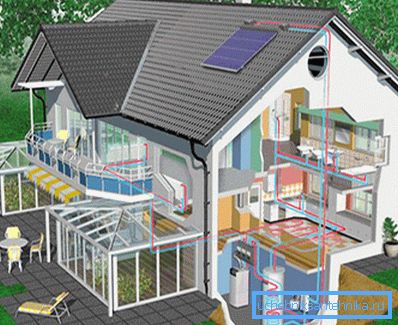
General information
When designing these systems in the city limits, there are no particular problems. In high-rise buildings, the heating and hot water supply is centralized at all, so all the work is reduced to distributing pipes in the apartment.
In the case of a country house design features are that:
- in the case of heating installation of the boiler is required. There are more exotic ways of heating homes, for example, using solar collectors for home heating systems;
- water supply is also impossible without ancillary equipment. If it is enough to crash into a pipe in a city, then for water supply, you need, first, a water source (a well, a well), and second, a pump to feed it into the house;
- the sewage system is also becoming more complicated - because we don’t have the opportunity to dump all drains into the street network. Therefore, so that the entire site does not turn into a “fragrant” cesspool, you need to take care of wastewater treatment.
So, heating + water supply + sewerage of a country house is a task that requires serious attention. Further details on each of the systems.
More about design
When designing these systems, the main focus is on autonomy. Still, out of town there are possible interruptions in electricity and it’s good if this happens in the summer, but in the winter time the dependence of heating, for example, on electricity can play a cruel joke on the residents.
Heating system
The main elements of the heating system of a country house can be called:
- boiler;
- circulation pump (not needed if the version with natural circulation is used);
- pressure gauge;
- thermostats;
- expansion tank;
- pipes and radiators.
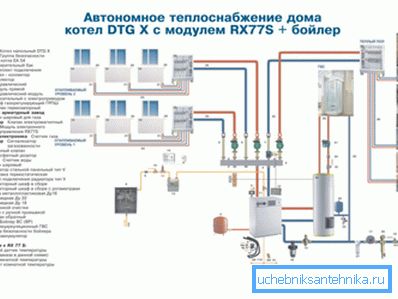
The main difficulty is to achieve complete autonomy of the system.
If it is the independence of the work of heating from external sources of energy, such as gas or electricity, that we put at the forefront, then we can offer several options for housing heating systems:
- using a solid fuel boiler (suitable models that can work on wood, coal, pellets, etc.);

- solar collectors - suitable only with sufficient illumination of the area;
Note! Quite often, solar collectors are used as an auxiliary source of heat and work together with a traditional heating system. At the expense of it the economy is reached and the price of heating decreases, the solar energy is free.
- gas heating can also be autonomous. The problem with the gas supply can be solved by installing a large capacity in the yard and periodically replenishing it with special services;
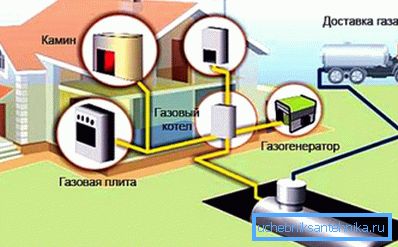
- As an option, you can consider installation, emit hydrogen from water.
Water supply
As for the water supply, the intake is performed from a well or a well (differing in depth and diameter). The pressure required to supply water to the house is created by the pumping station. Used pumps have a large power range and can organize a stable water supply from a depth of over 100 m, which is more than enough for private construction.
The main elements of the water supply system are:
- submersible pump - is placed directly in the well, its task is to supply water to the house;
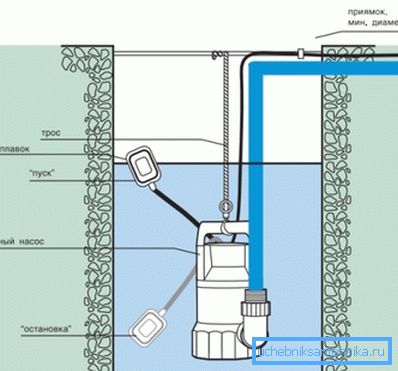
Note! When installing a submersible pump, observe the minimum distance to the bottom. It should not be less than 1.0 m, otherwise debris from the bottom will be actively absorbed.
- ball valve;
- pressure gauge;
- cleaning filter;
- hydroaccumulator.
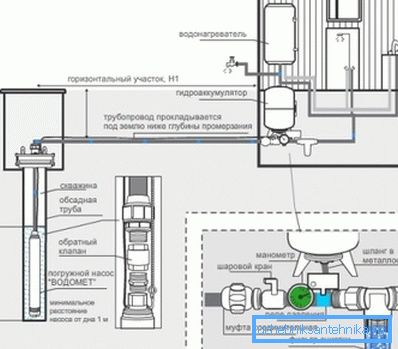
In principle, the use of a hydroaccumulator is not necessary, but this simple and inexpensive element will reduce the load on the pump and ensure greater independence of the water supply system.

Outwardly, such a device looks like a solid metal tank. Inside it is a rubber membrane, and the space between the rubber and the metal wall is filled with air under pressure. During operation, the rubber membrane is filled with water, and the pressure switch continuously monitors the pressure in the membrane.
As a rule, such systems are equipped with automatic devices, which turn off the pump when a pressure of 2.5 - 3 bar in the diaphragm is reached. That is, the pump operates cyclically, but not constantly.
Note! The use of a hydroaccumulator makes the water supply system even more independent of electricity. Even when the power supply is turned off, the accumulator will provide pressure in the pipes for some time.
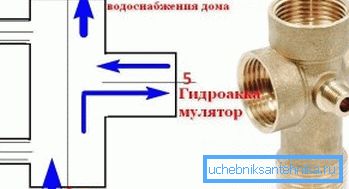
Sewage
When designing, it is necessary to take into account that the drains will not be discharged into the centralized system of sewage disposal. So you need to provide a container for the storage and processing of polluted water.
The best option can be considered the use of a septic tank. The two-chamber design allows you to completely recycle waste water and get water at the outlet that does not harm the environment. It can be safely used in household needs.
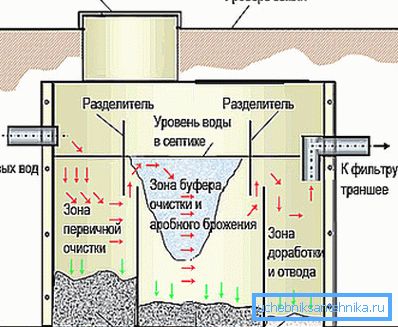
You can use the usual cesspool, but in this case you will have to use the service of pumping out its contents quite often. Such an option as a drainage well should be considered only in the case of a small amount of wastewater.
As for the installation of sewage, the instruction provides for the laying of pipes, ranging from the septic tank (sewage pit, drainage well). At the same time, 110 mm pipes are used for the outer section of the sewage system, and smaller diameters (with the exception of the riser) are used for wiring to the apartment.
The last connection is the sanitary equipment. Water traps are installed to prevent unpleasant odors from entering the rooms.
Summarizing
The principles of designing a heating and water supply system for a country house are not very different from solving the same problem in an urban setting. The main feature of such systems can be called maximum autonomy - it makes certain adjustments to the project. The proposed material briefly describes the main features of autonomous heating and water supply.
The video shows a boiler room for heating a house with an area of 120 m.2.